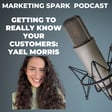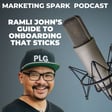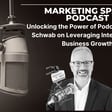Become a Creator today!Start creating today - Share your story with the world!
Start for free
00:00:00
00:00:01

A Deep Dive into B2B SaaS Pricing
When should a B2B SaaS company change its pricing and how often should it happen?
How do free trials and freemium play within the pricing equation?
In this episode of Marketing Spark, Dan Balcauski and I explore the pricing landscape.
We look at who should be responsible for pricing, know when prices have to be increased and know when your pricing is working.
Pricing may not get the attention it deserves so Dan has great insight into its role and how to think about it.
Transcript
The Overlooked Pricing Focus in B2B SaaS
00:00:06
Speaker
It's Mark Evans and you're listening to Marketing Spark. I've worked with B2B SaaS companies for more than a decade. There's a huge amount of time, energy, and money focused on product development, sales, and marketing. But pricing almost seems like an afterthought.
00:00:24
Speaker
There's so much focus on attracting customers to validate the product's viability. In some respects, it's like making sure your hair is just right for a big date, but you go out wearing a t-shirt and jeans. Now it goes without saying that pricing is important, so it needs just as much TLC as other parts of the business. Let's take a deep dive into pricing.
Expert Insight: Dan Belkowski on Pricing and Packaging
00:00:46
Speaker
And to help me do that is Dan Belkowski, the founder of Product Tranquility, a consulting firm based in Austin, Texas.
00:00:54
Speaker
Dan is an expert in helping B2B SaaS CEOs define pricing and packaging for new products. Welcome to Marketing Spark, Dan. Thank you for having me, Mark. I appreciate the intro and looking forward to our conversation. As I mentioned off the top, when we were talking, I got a lot of requests from podcast agencies to have guests on my podcast. I reject about 95% of them easily. Most of them get deleted automatically, but
00:01:20
Speaker
When I got the pitch from your agency, it resonated immediately because pricing is something that is obviously very, very important but never gets talked
Strategic Oversight: Neglecting Pricing in Executive Discussions
00:01:31
Speaker
about. First question, do you think I'm being overly dramatic about B2B SaaS companies and pricing or does it reflect what's really going on out there?
00:01:42
Speaker
Yeah, I don't think enough companies pay attention to pricing. I was recently working with a SaaS CEO on pricing. As we're going through the proposal process, in the middle of that, they had a three-day executive strategy offsite.
00:01:59
Speaker
Monday morning, I have a follow-up meeting with the CEO. I go, okay, hey, I know we're talking about this pricing project. What's changed in regards to this project based upon what you guys discussed in the meeting? And he said, we didn't discuss pricing. Can you imagine that? Three full days with the entire executive team. This is a very successful Silicon Valley company and series B company, incredible amounts of momentum and intelligence. It's not for lack of
00:02:26
Speaker
skill, but just was not paying any attention to that lever. Given the impact that I know pricing can have, I guarantee in that three days, there were less important items that were discussed or spent time on while you had the entire attention of the executive team. I don't think it really gets enough attention at any stage. I don't want to pick on early stage companies.
00:02:49
Speaker
I was recently at the Professional Pricing Society conference actually just last week, and that was one of the topics we were discussing even among the largest of companies. We've made progress over the last decade in terms of even the largest companies have dedicated pricing teams and professionals, but I think there's still work to go in convincing the rest of the world that pricing is actually a thing and deserves more attention. There's so many
00:03:15
Speaker
Places we can go from here it is interesting to me because I spend a lot of time working with b2b sass companies on positioning and website copy and messaging about pages for example are almost in a sense the equivalent of pricing because a company will do all this great marketing and there about pages and afterthought you go there and it's like.
00:03:35
Speaker
This is so confusing and doesn't even reflect the brand stature and the people and the excitement about the company. And then you go onto the pricing page and it's the same kind of thing. It's like, that's it. They really didn't think it through that well. And I guess the obvious question, why is pricing almost like that child that gets shoved into the corner? Like it doesn't get a lot of attention when other parts of the business are obsessed over.
The Imbalance: Acquisition vs. Pricing Strategies
00:04:00
Speaker
Is it just something they don't think about? Is they just, are they so focused on getting the product?
00:04:05
Speaker
to sales period. Explain that to me, because it's a mystery. It's a great question. And I wonder about this a lot myself. So I could give you my theories. But I think every each individual company would have its own reasons. I think there's really three ways to grow, especially a SaaS business. Customer acquisition, monetization, and retention. Acquire more customers.
00:04:32
Speaker
keep those customers around, continue to pay you and sell them more or change how you're monetizing. And I think that acquisition
00:04:42
Speaker
sucks up all the oxygen in the room. And it's really not until folks hit some structural break where maybe they have a brand new product or they're going after a new market segment or something else breaks in there. They would do a competitor that shows up that's like, oh, we actually need to focus on this other monetization lever. I think it's just all about acquisition. And I think part of that as well is
00:05:05
Speaker
There's not really, pricing has this black box voodoo aura to it, I guess you would say, where people, if you're a manager and you're asked to control your costs, well, I can go count my costs. I can ask the finance team, give me all the costs for my AWS infrastructure and how much are we paying the engineers and let's make all that more efficient. We're talking about pricing.
00:05:28
Speaker
really good academic boot camps. We've made progress in the world of product management over the last 20 years. There wasn't much training in the world of product management. It's sort of a go do it yourself. The worlds of data science and even programming have now shifted to all these boot camps. But I think pricing still doesn't have that background.
00:05:49
Speaker
If you're a marketer, you're like, okay, I know how to go use HubSpot. I know my demand engine tools. That's very concrete to me. This other thing I'm not so sure about, it's scary. So let's put it in the corner and not talk about it. If you're a B2B SaaS entrepreneur or CEO, you obsess over KPIs like cost of acquisition, lifetime value. Those matter to you. You look at those numbers all the time. If you're trying to scale your company,
00:06:18
Speaker
And those are all predicated by revenue, which is obviously driven by pricing. So there seems to be a disconnect because key metrics are front and center, but the fundamentals, the underlying
00:06:31
Speaker
pillars of the business are ignored. Again, I'm just curious about why you think that happens. They don't even think about it. It's almost like it's something that they make up on the fly. Yeah. There's a couple of different things. I've talked to executives who are just scared of touching pricing. It's like we have the thing, it's working
00:06:52
Speaker
I don't want to touch it. They feel much more comfortable breaking something else. Also, what I found is some amount of skepticism that you can do actual research and provide a structured approach around pricing.
00:07:11
Speaker
It's funny because i've talked to many folks in the user experience research world. About pricing research specifically looking for help for folks to come on and do some help me with some of the pricing projects i work on interviewing some of these folks it's interesting responses i get where.
00:07:28
Speaker
they have this mindset where, hey, we can't ask people about price because we're only going to get a biased response. And I get that at one level in that, okay, yeah, that's a fair objection, but that wasn't the first time that anyone's ever thought of that. There have been academic researchers for
00:07:45
Speaker
50 years who have realized that, okay, there's bias and what are the different ways we could ask these questions, et cetera. And just mind blowing because I spent a long time in the product management, product strategy world. And that's why I went to these UX research experts and said, well, you can't get good feedback from a mock-up because that's not the real product. And so you're going to get biased input. It's like, okay, yes you are, but you're going to get enough input to move the ball forward. You're going to resolve a lot of uncertainty that you have today. So I think it's a combination of those factors of we don't want to break what's working.
00:08:15
Speaker
and maybe some skepticism that there's actually some science, some structured way to unravel this black magic voodoo that if you haven't looked at it closely enough, you just maybe assume that there's nothing to be done there or it's just all just guesswork anyway, so I might as well shoot from the hip. If we operate under the assumption that pricing doesn't get enough attention and it should, the obvious question is how should companies
00:08:45
Speaker
approach pricing both early stage, where they're trying to find product market fit, they're trying to attract customers. And then latter stage, where the business is rolling, you've been operating with a pricing model for a number of years, but you're not sure whether it's actually optimized or not. Is there a common approach that
00:09:07
Speaker
different types of companies should take to pricing?
Early-Stage Advice: Avoid Freebies to Validate Markets
00:09:10
Speaker
Yeah. There's a couple of different sub questions in there. Let me just touch on first back going on a life cycle or company stage. I think it's important when you're very early to charge something. Don't just give your product away for free, but charge something. And the reason why that's important is because if you just give your product away, you're actually not getting validated market feedback.
00:09:32
Speaker
We might touch on this later. I'm not a big fan of freemium. But one of the problems in a freemium as well as just giving your product away is you tend to attract a bunch of users who will never become customers. And those folks may have different needs and steer you in the wrong direction with their feedback. Also, you're not forcing people to actually make a trade-off. So when you're talking about, I'll give you this product, that's pure value. When I ask you for a price, that's pain. They've done neurological studies, the price
00:10:00
Speaker
actually activates the pain centers in our brain and so it really forces our brains to think about a decision differently and so you're not really getting validated market feedback if you're not charging anything. So charge something.
00:10:12
Speaker
Going back to your broader question, pricing is a process. Anything you do in your business can be thought of as a process, has inputs, there's outputs. Aligning unexpected outputs and what goals you want to get out of that is critical. So understanding from the beginning, how important the relative priority of this project related to everything else that we could possibly do, the discovery internally related to what is the work we've done,
00:10:39
Speaker
aligning the team on what is the goals that we're trying to accomplish, executing some amount of research, whether that's with internal data or external market data, testing and iteration, and eventually decision and implementation. I have a four-part model that we can apply that basic process to. It's the acronym SVCS, so services. It was a happy coincidence. I didn't plan this. But it works for SaaS pricing specifically. So starting with your customer segments.
00:11:09
Speaker
then the value create your competition and strategy. So that's the SVCS. How does that work? So understanding your customer segments first is incredibly important. Why? Because your market is not homogenous. Your customers will have different value drivers and they'll rank those different value drivers differently, which will cause them to value your product differently, as well as they have potentially different competitive alternatives that they may have available to them.
00:11:37
Speaker
Value and competition are incredibly important. Obviously, you can only charge a price in line with the value you create. But in a market economy, specifically the differentiated value that we create for customers is where our pricing power comes into play.
00:11:54
Speaker
filtering, if we think about those first three components I talked about, your customer segments, understanding the value you create for those segments, the competitive alternatives you're up against, that we filter those as sort of the research inputs into your overall strategy. And this is where you come to make the decisions around the things like you mentioned. Given the segments that exist in our market, who are we best suited to serve, play, and win? So who are we going to target? How are we going to position ourselves in the minds of those customers so they understand our unique differentiated value?
00:12:24
Speaker
How do we create the packaging such that we align to the value drivers that those segments understand and that we have offerings potentially for different sub segments of those customers? So really bringing that together and understand your pricing is not just a single dollar value. It's a set of interrelated decisions that all have input from those different components I just mentioned.
00:12:52
Speaker
If we agree that pricing should involve a structured process, research, competitive analysis, and the fundamentals of making the right decision using the right inputs, then ultimately, who should be responsible for pricing? Is it the CEO, the head of sales, marketing, customer success, or is it a group decision where everybody within the company, like they do for positioning and messaging, needs to be aligned so that you can move forward in lockstep?
00:13:22
Speaker
Yeah, it's a great question and one that comes up often because we could have the best research in the world and that runs into an exec team that is not aligned and no one has decision making authority and the best research in the world is not going to move that group to a decision that will get implemented and it will just get lost.
00:13:42
Speaker
In the beginning, founders own pricing because there's no one else to do it. But as we discussed, many companies and many founders aren't spending a whole lot of time on that process. In larger established companies, I would make the argument that product marketing should own it. I would say product marketing or product management. The problem with product management is usually the chief product officer, VP of product, has so many other priorities on their plate that they are unable to give pricing the attention it deserves. I think both of those
00:14:10
Speaker
positions are closest to the customer in terms of deep customer insights, but they also have a strategic position inside the company. They understand the company goals at a deep level. They understand the value that they're creating through the product. Obviously, PMM has a very strong role in owning the positioning, which I think positioning your pricing is a function of your positioning. And so having that shared ownership is quite valuable.
Ownership of Pricing Decisions and Stakeholder Input
00:14:35
Speaker
They understand these ideas we talked about before of segmentation, targeting, and positioning altogether, which is core to the pricing process. Now, you asked, is it a group decision? I believe that you should have a pricing committee or a pricing council because everybody at the executive table is a stakeholder in that decision. Sales, finance, customer success, product management,
00:15:02
Speaker
they all have a credible amount riding on the outcome of that decision. And so I don't think that it works to have one function, I guess, minus the CEO, but the CEO usually doesn't have enough time to do the research either. So minus the CEO to come in and dictate to the Orissy organization. But I do think that product marketing person should have decision
00:15:26
Speaker
authority, but be leading and incorporating the feedback from the rest of the pricing council. And that makes sure that all those stakeholders views are represented. We do this with, if you think about product management, this is the whole role of product management. You have engineering team who say, all right, what do we go build? A lot of different opinions in the building, including those of customers outside the building. And the role of the product manager is to be that
00:15:51
Speaker
walking persona of the product, listening to all the opinions, balancing all the trade-offs that need to be made in order to achieve the objectives the businesses outlined and move forward because otherwise decisions will be made. You've got a bunch of engineers sitting there burning time, not building the things they should be building. And it just sort of boggles my mind. We don't treat pricing the same way. It's because it has an incredible impact on moving the business forward. One of the things I wonder about
00:16:19
Speaker
when companies are trying to get a handle on pricing is how they can tell whether it's working or optimized. Obviously, they can look to customer acquisition. If we're getting a healthy number of customers, then that's a sign that our pricing is attractive. The other is obviously revenue. So if we're hitting our revenue goals, then that means our pricing, theoretically, is working. But if you take a step back and look at it from a higher level perspective,
00:16:49
Speaker
What are some of the things that companies need to think about? A, to make sure it's working, to make sure that it's actually competitive and it's attractive. And B, it's optimized because companies could sell a product and they could be 25% below optimized price, but not even know it. So what are your thoughts on those two?
Evaluating Pricing Effectiveness with Key Metrics
00:17:08
Speaker
Yeah, it's a great question. It's a difficult question. I don't think that there's any one perfect answer for your price point or your packaging. You're always balancing different trade-offs and different decisions based upon your competitive alternatives, sort of the market dynamics, the strategic imperatives of your business, where your product is and the life cycle, the type of customers that you have.
00:17:31
Speaker
As you talked about, are you hitting your goals? Is pricing getting away with those goals? I think that'd be the first question. Also, are you having regular conversations about pricing? Is it being brought up in your quarterly exec strategy meeting for at least one of the 30-minute sessions I think is worthwhile of having that conversation?
00:17:52
Speaker
Some of the metrics that you might take a look at, things like understanding your discounting percentage can help inform if your price is too high or too low. One thing is I'm of the opinion that if you don't have any prospects complaining about your price, that's a problem. So you normally should, somebody's going to be relatively unhappy, but it shouldn't be everyone. But if you have no one complaining about your price, you're definitely undershooting the market.
00:18:21
Speaker
With discounting, you can look at those numbers purely and then you can also look at price bands, so identifying customers that are paying significantly more or less than pure customers of a similar size and tenure with the company. Wide price bands are often a signal of a significant pricing opportunity.
00:18:38
Speaker
looking at things like churn and net revenue retention. So are your churn and net revenue retention in line with similar companies? And I've written a lot about churn. It can get very complicated to compare to the proper peer groups. So a one size fits all churn number, if I quoted it now, would not fit for some large percentage of the audience. But making sure that
00:19:04
Speaker
The feedback you're getting from customers, are you aligned to the value that are the perceived value that customers are actually experiencing from your product? And are you seeing a healthy amount of expansion from those existing customers? You know, I'm a big fan of using
00:19:20
Speaker
win-loss data and win-loss analyses. You're going out and actually talking to lost prospects to get their perspective. I think win-loss codes are a good start, but it's all too easy, especially to B2B context for a prospect to tell your sales team, hey, price is the issue. When you go out and dig a bit deeper,
00:19:41
Speaker
you usually find that price wasn't the number one issue. So really trying to understand behind the scenes what is the real cause of you not winning that particular deal. Because in a B2B context, price ends up usually being somewhere in the third to seventh most important decision in the buying process. But you don't see that usually when you just look at the win-loss codes. It usually is like the number one bucket. But when you go and dig in there, you obviously find a bit of a different story.
00:20:09
Speaker
And then also churn customer interviews, going out and having those conversations with customers, trying to figure out what are they doing now to solve that problem? Maybe you're losing some insight on a new competitor. We think about competitors very rigidly.
00:20:26
Speaker
A lot of startups are actually competing with spreadsheets and email. Did your software not even beat the spreadsheets and email? They just went back to having Joey the intern maintain some spreadsheet or did they choose some other way of doing it? It can give you a lot of product innovation insight, but then also understanding where your value is relative to your price. In the marketing world,
00:20:50
Speaker
marketers traditionally have relied on the four P's, but in the pricing world, one of the things that you mentioned before this interview was the three C's of pricing. Can you talk about each one?
The Three C's of Pricing: Cost, Competition, and Value
00:21:01
Speaker
Oh, our marketers, we love our handy acronyms, the STP, the four C's, the Porter's Five Forces. We love all of our little handy mnemonics. So yeah, the three C's of pricing, real quickly, I'll talk to them and then I'll explain them a little bit more. So it's cost-based pricing, competition-based pricing, customer value-based pricing, often referred to as just value-based pricing. But if we just said that, it wouldn't be three C's. The way I look at this is it's a progression.
00:21:32
Speaker
It's totally fine if you're starting at cost-based pricing. You've got some cost of goods sold. You've got to keep the lights on. You've got to pay the rent. How much does it cost you if we're going to sell this product to maintain a profit so we continue to deliver value? If you're going out the door, the first blush,
00:21:54
Speaker
absolutely fine. Not the place you want to stay long term, but it's a starting point. It's relatively simple, clear cut, data you need is easy to find within your company. I will say for each of those, the way I think about this as a progression or a ladder is because
00:22:12
Speaker
you really can't get to like value-based pricing. You still need to understand your costs even if you get there. So you need to sort of understand all of these things along the way. You don't get to just ignore it. Just be like, oh, I only focus on customer value. Well, maybe customers want to pay you below what your costs are. You're not going to be in business very long. So you better have an understanding of your costs.
00:22:30
Speaker
Then you get to competition based pricing, which it's like, okay, before, if you're considering costs, you know, you just add some, some markup to that. Well, you're living now in a very insular reality. You're completely cut off from the reality that your customers are facing because your customers are evaluating other available alternatives in the market.
00:22:51
Speaker
and comparing you to them. And so looking outside of your firm at what are the other possible alternatives that customers could use? How are they pricing? And trying to understand, do we believe given our lifecycle, our maturity of our product, are we at a premium or a discount to those competitors? So using sort of now those two inputs of cost and competition to help inform your overall pricing and packaging approach.
00:23:18
Speaker
And then finally, the value-based pricing, which I would say is the North Star. It's a destination never to be reached, but always to be strived for. The value here is it's customer-focused, directly aligning the company's profitability with the company's value, or the customer's value, rather. The idea here is with competition-based pricing, much like we were talking about before the focus on demand generation, you would never give your competition
00:23:46
Speaker
control of your demand generation strategy. But when people just stay at competition-based pricing, they're basically outsourcing their pricing function to their competitors, which no CEO would ever consciously do, but effectively that's what they're doing. I've been on the product management product strategy side and one thing I learned very early on was
00:24:06
Speaker
to be very cautious when you see competitors releasing a set of new features, being like, oh, this is what the market wants. Because you're making this underlying assumption that their product managers actually have a process that they've been following. Same if you follow their pricing. It's like, oh, they've actually done their homework in the correct way. So you don't want to stay there because you're then at the mercy of your competition. The other question that I wanted to ask you is how companies should approach
00:24:33
Speaker
Price changes. I was working with a client recently. I'm working with a client. One of, I spent a lot of time looking at the product, the competition, and we got to pricing and their pricing, you know, the sniff test, it seemed wrong. Now in this case, what was happening is they had, they had a free product for students. They had a cheap product and they had an enterprise product and the gap between the pricing bands.
00:24:57
Speaker
was dramatic. And from a outside in looking perspective, it seemed off.
The Importance of Regular Pricing Revisions
00:25:05
Speaker
So what we did is we adjusted the price now be it and I'll concede this as a maybe something we did wrong is we made an educated guess. We were trying to be agile. We were trying to reposition the company. So we we guessed on pricing. Part of it was that the top tier is enterprise. And like a lot of companies, it's called the
00:25:24
Speaker
call to get the answer. So we're not going to tell you the cost until you tell us what you need and then we'll make it up as we go. And that's a long winded question about how often should companies change their pricing and how did they determine if they should do it and when's the right time? There isn't one magic number that specifies how often to revisit pricing. It generally makes sense to revisit at least once a year or whenever a change in the product or the market would necessitate a review.
00:25:54
Speaker
Companies, product managers, engineering design teams are constantly evolving your product. You're constantly changing the value. It makes sense to reevaluate your pricing in line with changes of value. And maybe you're not doing that with your shipping in an agile fashion, pushing code.
00:26:11
Speaker
multiple times a day to production. I'm not saying changing your pricing every day is a recommended thing, but you do have step changes over time. We are a significantly different product than we were a year ago. Our competitors have significantly changed and therefore it's time for us to revisit.
00:26:29
Speaker
I saw some data, I don't remember where it was, but companies that did more pricing changes, and again, I'm not just talking about the number, but this could be creating new add-ons, doing pricing localization, making tweaks to the display of the pricing pages, showed higher growth over time. So there is some correlation, again, causation correlation, unsure, but companies that are revisiting your pricing more often are showing higher growth over time.
00:26:53
Speaker
If you're talking purely about pricing increases, again, I'd mentioned this before, if you don't have any prospects pushing back on pricing, that could be a signal that it's maybe time to look at it. Customers maybe explicitly, if you're a product manager, they might not say this to sales, but if you're a product manager and customers are telling you how cheap you are, that might be a good signal.
00:27:14
Speaker
If you have a very clear understanding of the return on investment or ROI that you create for customers and you've validated that with customer data and you can bring that to the executive team, that might be a good opportunity. Again, if you haven't touched pricing in years, this is coming back to bite a lot of people because now there's some real concern about inflation.
00:27:36
Speaker
And now people are like, oh no, we haven't touched our pricing for years and all of our costs just went up because of wages and cost of goods. And so now we need to make another, a much bigger adjustment that we were, you know, we were planning on touching it and now we have to do all this catch up work and like then forecasting what's happening in the future. We didn't touch on this before with metrics, but another thing is most companies in the SaaS world have different offer bundles or configurations, which are like a good, better, best. In those situations, you know, you'd like to see a
00:28:06
Speaker
somewhat balanced purchasing across your different offer configurations. So there's not a hard rule of thumb, but some people will say like 25, 50, 25. So 25% at the least expensive version, 50% in the middle and 25% at the high. If you start seeing
00:28:26
Speaker
90% or buying your highest that could point that like, okay, well, actually, you know, our highest may be under priced and you know, there's or there's not enough value in our lowest we need to balance those things. I want to ask you about two pricing related sales and marketing approaches that a lot of B2B SAS companies take one is free trials, 70 trial 14 to trial 30 day trial, what are your thoughts on free trials? Because in many cases,
00:28:55
Speaker
What I find is that it's hard for a prospect to determine the value or price of a product because they don't get the full experience. They may get a truncated view with a free trial. So when it comes to making a buying decision, they've got a taste, but not really. So do free trials, do they work and how, what's the relationship between a free trial and pricing?
00:29:19
Speaker
Yeah, so I think of free trial as almost an acquisition strategy, less so a monetization model. I do believe free trials work and there's good data that shows this. Now, if we're going to nerd out for a second, the idea of a free trial comes from what economists would term software as an experience good.
00:29:42
Speaker
So, an experienced good is a type of good that your perception of the value changes as you use it. So, if you imagine you go to a restaurant, you might see what's on the menu, but it's not until you taste that Wolfgang Puck and stuff by your dish that you're like, oh my God, now I see why this salad was $95. It totally makes sense to me now. And we talk a little bit about tactics, but I worked for
00:30:02
Speaker
several different companies had free trials and the ideal from there and a lot of other research I've seen is 14 to 30 days and the benefit of a free trial is there's an expiration point. So your go to market motion is very clear where customers see the value
00:30:21
Speaker
or they don't, and then they make a decision. And that decision might be any more time, in which case you've got a salesperson who maybe has a trial extension key that they can hand over based upon how the conversation is unfolding. But it creates a decision point at which it makes sense to either go with the software or not. Now, there's a lot involved in making sure that those free trials are optimal.
00:30:43
Speaker
everything from onboarding flows, customer education. At that point, it's not really a pricing decision. It's really making sure that the value is very clear and that the entire marketing growth product management team is doing everything they can to support the value proposition of the product. The other lever that a lot of P2B SaaS companies pull is freemium, which you touched about earlier.
00:31:09
Speaker
It strikes me that freemium was a lot sexier and captured a lot more attention a few years ago. Maybe it's because freemium has become old hat. It's just part of the sales and marketing and product landscape.
00:31:22
Speaker
What are your thoughts on freemium? Because in some senses you're giving away your product for free, trying to win people over by showing them the value and then hoping that some of those people actually like the product enough so that they'll upgrade and they'll find the pricing to be acceptable because they've seen the value. Any thoughts or I'm sure you have thoughts on freemium, how and when it should be deployed?
00:31:48
Speaker
Yeah, I absolutely hate freemium, so thank you for the question. This is actually my first foray into the pricing world. So I did my MBA, and during my MBA, I went out to Silicon Valley, worked for a very successful Silicon Valley startup there.
00:32:05
Speaker
They had a problem where they sold apps like for your phone, but they went to market through these four large go to market partners. One of the go to market partners was incredibly concerned about being perceived as the low cost player and made all of their app developers have a freemium version of their app.
00:32:24
Speaker
On the table, a CEO is a strategic choice that he had to make when I showed up, which was, hey, we have to do this freemium version of our apps for one of our go-to-market partners. Should we have it for all of them? Dan, go. So I threw me into research for a good part of that summer, among several other projects completed for them. Really, it turns out to be generally a terrible idea for a whole host of reasons. Most of the arguments that people make in favor of freemium
00:32:52
Speaker
are better suited with a 14 to 30 day free trial instead of freemium. It's a very bad idea except in a few rare cases. So the first thing to think about is that it's very challenging to move customers from free. I was talking before about the free trial
00:33:08
Speaker
end of that free trial, there's a decision point. There's no decision point in freemium. It's sort of this lingering continued usage at which you, there's a lot of hope involved in the freemium strategy, I would say of like, oh, eventually these people will become paying customers. This is an illusion. Best in class freemium, you're going to convert one to 3% of those users into customers, which by definition means you have to have a massive market.
00:33:36
Speaker
like millions of potential customers. So when I talk about some rare cases, people are like, oh, well, Zoom has free. I'm like, okay, with COVID, every person on the planet was a potential customer of Zoom. So they have a massive market. In their case, it's the free works as well as they have embedded network effects because I invite you to a Zoom call, then you use Zoom. So there's a couple of these situations where it does make sense.
00:34:01
Speaker
There's an incredible amount of energy misspent inside of businesses because again, you look at these 99% of users who will never become customers. And look, growth teams are working incredibly hard to acquire new customers, right? They're going out every day, working SEO, social, paid, paid search, et cetera, trying to acquire customers. And you're looking at this giant pool of potential users like, oh, if we just tried a little harder, I'm sure this giant pool of users would convert. And then you spend
00:34:29
Speaker
all of this energy and money trying to move those people who never will actually convert. It's a mirage and I think it's a giant waste of energy. I think that there's some debate going on right now that, well, it improves your customer acquisition costs. I think this is a
00:34:45
Speaker
playing games with the income statement. So for those of you who aren't aware of the cost of acquiring a customer is your sales and marketing expense divided by the number of customers you've acquired. As soon as you do freemium, it can look like your customer acquisition costs went down, but that's because you took a giant portion of the engineering and product design teams and put them into marketing and didn't account for that when you did your CAC calculation.
00:35:06
Speaker
So if you did that, I'm pretty sure actually the numbers wouldn't look as rosy as they're normally do in that situation. Again, you know, there are some rare cases for the vast majority of arguments, I would say, you know, free trial works. And here when I'm talking freemium, I want to be very explicit because some people will be like, Oh, well,
00:35:22
Speaker
We could do an ad-supported model. In that case, that's very different. I don't say that that's an ad-supported model. I don't call Facebook freemium. It's a multi-sided network with an ad-supported model. So freemium is purely like, oh, we get no money. There's no revenue from these free users. But going back to what I was saying before, in terms of some cases where it can work, I think Zoom, where you've got this network effect from a marketing perspective and a giant, giant addressable market.
When to Use Freemium Models Effectively
00:35:48
Speaker
If there's developer-focused products where you have
00:35:53
Speaker
Potentially, a developer needs to use your products in dev and staging for months or maybe a year before they could move it into production, and you want to be able to give them that opportunity to do so. It doesn't make sense to keep on renewing free trial keys. Some of those type of products make sense, but if you moved it to production, the free version wouldn't be enough to actually use it there. Or something where it's like a built-in community. I think Slack is a good example where you don't want to show up to a party and no one's there.
00:36:19
Speaker
The product, is it useful unless all of your teammates are on the same time? And so just the fact that it has to be social in order for the product to actually function makes it so that they need to have a free version of their product there.
00:36:33
Speaker
I guess I could really, I could ask you, so how do you really feel about premium? I'm going to ask you actually a favor and some free consulting advice. I've got a client. What we're trying to do is create a new category. Like a lot of B2B SaaS companies, you know, the Nirvana is
00:36:49
Speaker
you don't compete in an existing category is you actually create your own subcategory or a completely new category and once you do that you sort of put yourself off to the side against all the other traditional competitors that you've battled against. What are your thoughts in terms of pricing when you're making that transition? When you've got this legacy product with legacy pricing but you're trying to reinvent yourself and in the process
00:37:17
Speaker
maybe trying to position yourself as a higher value premium product. How do you manage that journey?
00:37:25
Speaker
There's a lot in that statement. What I want to do first is call everyone's attention to the idea of how bad idea it is to go try to create your own category. I know it's thought of as the marketing panacea, but I do not recommend it. I highly recommend it. Folks haven't checked her out. April Dunford, she wrote a book called Obviously Awesome. She is a positioning expert. I absolutely love her stuff. She actually went and was talking on
00:37:49
Speaker
I can't remember where it was, but she had actually done some research because she gets this all the time, just being a positioning of people and like, Oh, well, like if we go create our own position, we'll be in a category of our own. And then looked at data of, you know, how many companies sort of when they went IPO had like created a market versus not right. A cub spot is the one that's always held out of like, they created the whole idea of inbound marketing and became the number one, you know, leader in that space.
00:38:11
Speaker
But then there's also all of the also ran you never heard of right i mean think of the creative and sony mp3 players that just got destroyed by the ipod you know in the list goes on where actually i think it for her research she did something like ninety ninety five percent of technology companies at ipo we're playing in pre-existing categories so very very small sliver of ipo stage companies actually going to create categories.
00:38:36
Speaker
So putting that aside, say you go down this road, I think the other question you sort of asked was, how do you change your price positioning? I want to go from the low cost player or maybe the average market player to a more premium player. It takes time and it takes investment. Customers' perceptions are sticky.
00:38:57
Speaker
So this is where the real work comes from. It's not that it's impossible, but this is the reason why, for example, Toyota created the Lexus brand when they went upmarket. Because while Toyota might, obviously Toyota and Lexus are the same company, but they realized it was easier for them to compete if they just created an entirely separate brand. There's ways you could do it and you could potentially move there over time. People do transition, but it's very difficult if your Toyota
00:39:25
Speaker
to then go compete with Lamborghini. I don't think you could even create another brand. You're like, okay, this is still a Toyota. I think there's even limits there in terms of the levels you can compete at. One final question in terms of how people can find you, and that's important. What are the triggers that would cause a B2B SaaS entrepreneur or CEO to
00:39:50
Speaker
Wake up one morning and decide, I gotta call Dan because something's off with my pricing. What do you find happens the week before, the day before someone reaches out to you and says, I need some help.
00:40:03
Speaker
Folks can find me at producttranquility.com. I'm also happy to connect with folks on LinkedIn at Dan Blachowski. Just let me know you heard me on the podcast so I could separate it from the rest of the LinkedIn spam. So usually where my clients come to me, it's usually some sort of structural shift. What's happened is, I guess, inflation, as I mentioned before, we could think of that as a pretty big structural shift. It's the highest inflation we've had.
00:40:23
Speaker
in 40 years. So it's usually not been a topic that anyone has had to think about for a very long time and suddenly becomes top of mind for a lot of executives, especially if you're on the finance side, watching your gross margins and your wages increase incredibly and trying to maintain some profitability and runway for your company. There's often
00:40:42
Speaker
If we're growing to a point where we're now starting to talk to new market segments and the way our pricing and packaging has been structured in the past is not working for that new segment. Potentially, I've either built or acquired another product and now I'm starting to manage a portfolio of products and now need to rationalize pricing and packaging across those.
00:41:04
Speaker
Perhaps I've even built just a significant new piece of functionality and now it's time to start thinking about, okay, could this be a separately monetizable add-on? So those are a couple of the different areas where folks start to experience a friction and realize, okay, we maybe need a little bit more rigorous approach as we start to juggle this.
00:41:21
Speaker
Well, this has been a fascinating conversation and it's a conversation that I wanted to have for a long time. I've talked about LinkedIn, I've talked about different marketing approaches, SEO, and pricing certainly doesn't get the attention it deserves. I want to thank you for being on the podcast and I want to thank everybody for listening to another episode of Marketing Spark. If you enjoyed the conversation, leave a review, subscribe via Apple Podcasts for your favorite podcast app,
00:41:45
Speaker
and share via social media. To learn more about how I help B2B SaaS companies as a fractional CMO, Strategic Advisor and Coach, send an email to mark at markevans.ca or connect with me on Facebook.



















